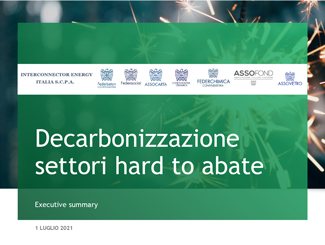 by Sara Seghedoni
by Sara Seghedoni
Italian ceramic industry: which decarbonisation?
A necessary approach for our planet's health may unveil its risks and open the way to social and economic tragedies, should decisions be guided by ideology instead of pragmatism
Italian energy-intensive industries have submitted to Minister of Economic Development Giancarlo Giorgetti, Minister of Ecological Transition Roberto Cingolani, and Minister of Agriculture Stefano Patuanelli a Boston Consulting Group study focusing on the impacts, risks, potentialities and futur developments of decarbonisation. The object of the study is to understand how much hard to abate sectors can de decarbonised by 2030 and 2050.
The industries addressed in the study (ceramic, chemical, cement, paper, foundries, glass, and steel) generate 20% of total Italian emissions, ceramic accounting for about 1%.
These industries generate 26 billion euros of gross income and account for about 60% of exports turnover. Their competitiveness is already at risk because of the Emission Trading Scheme. The study highlights that if these sectors bought the CO2 quotas on the market, they could be facing unbearable operating costs up to 15 billion euros over 10 years, between 8 and 20% of gross operating margin.
Decarbonising these sectors requires a diversified portfolio of solutions, some of which are not available yet: energy efficiency, circular economy, low carbon fuels, CO2 capture, green fuels (hydrogen and biomethane) and electrification could cut expected direct emissions by up to 40% by 2030.
The study also points out that in order to reach the 2050 targets, the three most innovative pillars should be exploited to the full: CO2 capture, electrification and green fuels (hydrogen and biomethane) which are not actually available as of today, and require different applications according to the sector.
As to the ceramic industry, the CCUS or Carbon Capture Usage and Storage strategy will have limited application due to low concentration of CO2 at emission points, and electrification is generally found to be of limited feasibility. The process towards 2050 decarbonisation targets therefore appears to have its focus on green fuels, which means replacing natural gas with biogas/biomethane or hydrogen (up to 50% as it may affect the quality of the finished product).
This will require a specific funding plan to support research and development in these sectors and the implementation of new technologies and energy vectors – as well as additional measures to back up those already in place (such as white certificates, cogeneration), and access tools to competitive green energy.
The partecipation of Confidustria Ceramica in the study does not entail its acceptance of EU legislative trends (and of ETS in particular) and its related costs. The Association will continue to act both at a national and European level and to pursue any necessary action to make sure that the Italian ceramic industry’s energy transition and its exposure to worldwide competition are compatible.